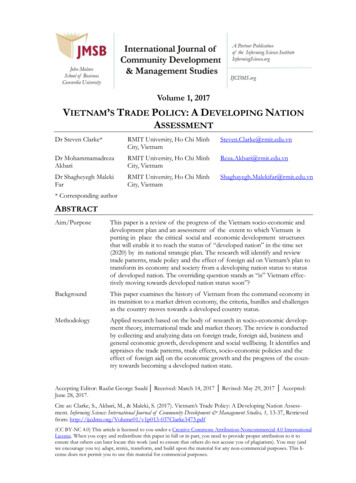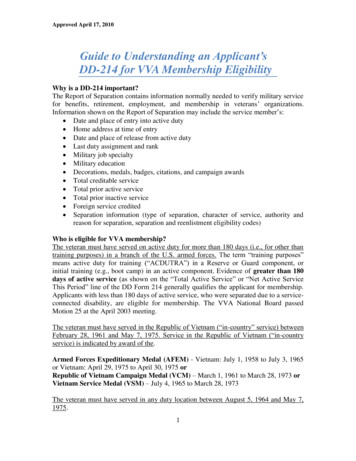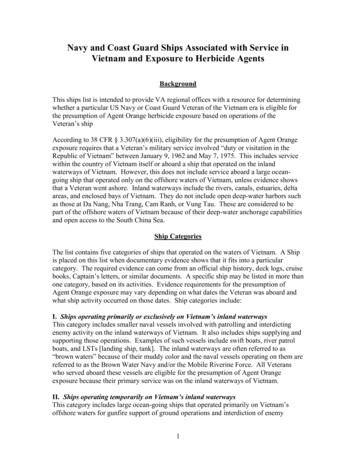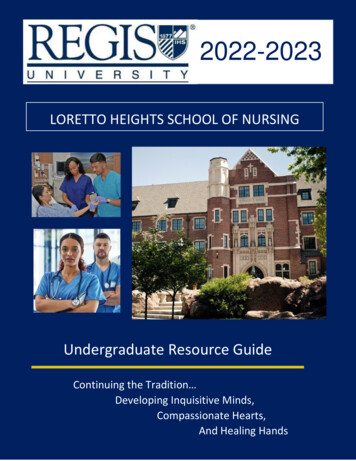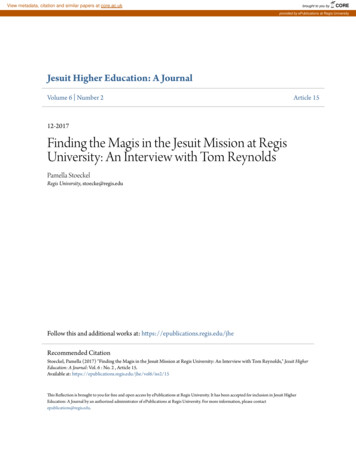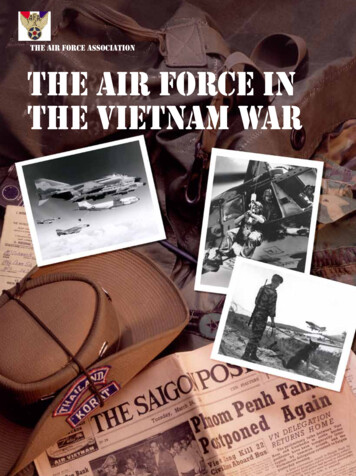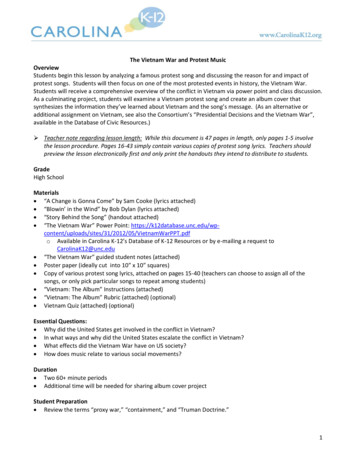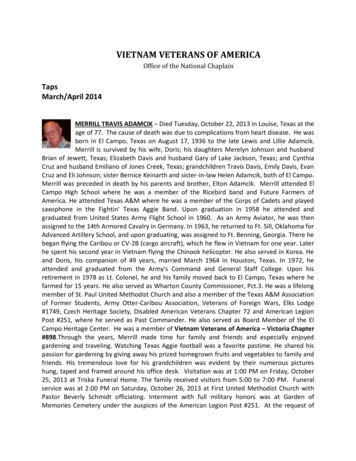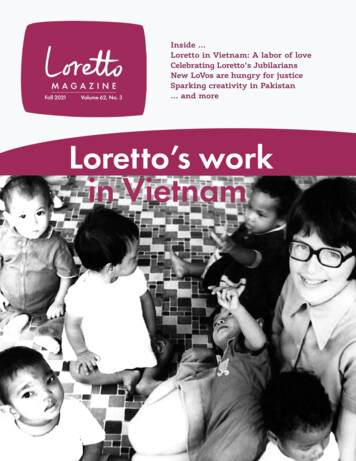
Transcription
Winter 2021Volume 62 No. 1Inside .Loretto in Vietnam: A labor of loveCelebrating Loretto’s JubilariansNew LoVos are hungry for justiceSparking creativity in Pakistan. and moreLoretto’s workin Vietnamoretto’s
LORETTO COMMUNITYIn this issue . . .Sisters of Loretto Co-members of Loretto“We work for justice and act for peacebecause the Gospel urges us.”Welcoming the child, loving our neighbor in VietnamPage 6Celebrating Loretto’s JubilariansPage 16Passion for justice motivates newest Loretto VolunteersPage 20In Pakistan, Loretto nourishes creativityPage 24RemembrancesPage 26Memorials and tributes of honorFront cover:Susan Carol McDonald SL is happilyswarmed by orphaned toddlers at NewHaven Nursery in Saigon, Vietnam.Susan, an RN who volunteered withchildren in Vietnam, nursed infants andtoddlers who were often in precarious health and helped send them toadoptive homes in the U.S. and othercountries.Page 28Loretto Community members teach,nurse, care for the elderly, lobby,minister in hospitals, provide spiritual direction and counseling, resettlerefugees, staff parishes, try to stopthis country’s nuclear weapons buildup, work with the rural poor, and minister to adults in need. Our ministriesare diverse.The Loretto Community, founded in1812 as the Sisters of Loretto, isa congregation of Catholic vowedSisters and Co-members.Loretto co-members are those who,by mutual commitment, belong tothe Community through a sharing ofspirit and values, and by participatingin activities that further our mission.For information on co-membership:Lisa Reynolds, Co-membershipCoordinatorPhone: 303-783-0450 ext. 1711lreynolds@lorettocommunity.orgPhoto courtesy of Loretto ArchivesMagazine Editor: Christina ManwellerEditorial Consultants: Mary AnnMcGivern SL and Jean M. SchildzProofreaders: Sally Maresh CoLand Mary Swain SLTribute Recorder: Virginia NesmithBack cover:Development Director:Mary Ann McGivern SLSusan Carol McDonald SL relaxeswith Mischa at New Haven Nurseryin Saigon, Vietnam; Mischa now livesin France.Below, Mischa is happy to be huggedby Naves as they play in the sandboxat New Haven Nursery.Photos courtesy of Mischa YarwoodLoretto Magazine is publishedthree times a year.Editorial Office:Loretto Community4000 S. Wadsworth Blvd.Littleton, CO 80123-1308303-783-0450Circulation Office:Loretto Office530 E. LockwoodSt. Louis, MO 63119www.lorettocommunity.org2 Loretto Magazine
Dear Reader,It is so interesting how life worksout, don’t you think?As I reflect on the courageousand compassionate missionarywork of Loretto Communitymembers in Vietnam, I remember a personal connection thatimpacted my own professionallife in nursing. I had been the director of nursing at theMotherhouse Infirmary in Nerinx, Ky., when in 1975 SusanCarol McDonald SL wrote to say that she was returningfrom Vietnam and wondered if there might be a place forher nursing services at the Infirmary. We were happy to welcome her to the staff and after a while it became clear thatperhaps it was an opportunity for me to explore anotherrole in nursing. That is how I became an oncology nurse atthe Baptist Hospital in Louisville; I applied for a job just asthey were opening the first dedicated oncology service inKentucky. My 36-year career in oncology began becauseof Susan Carol’s timely return from Vietnam.for a way of life in the Loretto Community. I never tire ofhearing the stories of life-changing decisions made and ofopportunities taken for “this” path rather than any other.Sister Nasreen Daniel presents to us a few of the creativechildren at St. Anthony School in Lahore, Pakistan. Our sisters are so gifted in recognizing a creative spark and gentlycoaxing it to new and unexpected brightness. I like to imagine these young ones rushing home and announcing: Lookat what I learned today!There is so much more to discover in these pages of LorettoMagazine! We love hearing from you. Tell us what especiallycaught your attention.In all the many ways in which Loretto lives unfold, you, ourfriends and benefactors, support us by prayer, affirmingnotes and letters, generous financial contributions and somany other personal and direct ways. Thank you, exceedingly. May your lives be blessed each day in ways you wouldnot even have imagined.How do you tell the story of your own life in which Godsomehow intervened in a way that beckoned to you?Sincerely, love,The lives of Loretto’s Jubilarians present some of the myriadand mysterious ways that each of us has responded, optingBarbara Nicholas SLPresident of LorettoFall 2021 3
spotlightLoretto participates in travelingSmithsonian exhibitionPhoto and text courtesy of Eleanor Craig SLThe exhibition “Crossroads:Change in Rural America”explored the resilience andthe challenges of rural life in theU.S. in the 20th century. In addition to the exhibit componentssupplied by the SmithsonianInstitution, Loretto’s curatorSusanna Pyatt led a team of civicvolunteers and Heritage Centerstaff in gathering interviews, photos and artifacts to create additional panels focused on MarionCounty, Ky. The result was greeted with universal enthusiasm asboth professional and touching.Susanna Pyatt, Curator at Loretto HeritageCenter, stands relaxed and relieved on thefinal day of the Smithsonian Institution’s“Crossroads” exhibition which brought 1,211visitors to Loretto City Hall in the month ofJuly 2021.Elaine Prevallet’s latest book now available onlineElaine Prevallet SL’s latest book, “A Path to the Divine in HumanLife: The Role of Chakras in Religious Dedication,” is available onthe Loretto Community website: hors/books“In these pages I want to share what has been, for me, a kind of journeyof integration. I start with the cosmos because it is critical that we understand how drastically and how speedily this world of ours has changedand is changing! I end with our hearts, alive and ready to be active participants in this present critical phase of our human adventure.”- Elaine PrevalletLook for an article about the book in the next issue of Loretto Magazine.4 Loretto Magazine
spotlight videoLoretto’s 30 years at the U.N.This year we recognize and celebrate 30 years ofLoretto’s presence at the United Nations.The Loretto Community is accredited with consultative status at the U.N., where we advocate on issuesimportant to the mission and goals of the LorettoCommunity. Our primary areas of focus are climatejustice, the rights of women and girls and the rightsof indigenous peoples and migrants. We also addressdisarmament, peace and security and financing fordevelopment.‘We bring grassroots voicesto the United Nations.’Beth Blissman, CoL, Loretto’sU.N. NGO (non-governmentalorganization) RepresentativeTo learn more about Loretto at the UN, please visithttp://lorettoattheun.org.Visit our Spotlight Video page to meet Loretto’s U.N.Representative, Beth Blissman CoL, and to step intoLoretto’s tiny U.N. office in New York City.See our most recent Loretto Spotlight video:www.lorettocommunity.org/spotlightVector World MapsBeth Blissman CoL, Loretto’s Representative to the U.N.Loretto’s presence at the U.N. began with Edwin MaryMcBride SL, who attended and reported on U.N. briefings in the 1980s. Pat Kenoyer CoL became interestedand together they created a proposal for the establishment of the official role of a United Nations N.G.O.representative, which was approved by the LorettoAssembly in 1991. Pat served as Loretto’s first officialrepresentative, with Edwin Mary as alternate, startingin 1992. From there, our work at the U.N. has expanded thanks to five additional representatives and morethan 40 volunteers.Fall 2021 5
Vietnam: answering the call‘Get your passport, get your shots; I need help.’Susan Carol McDonald SL to Mary Nelle Gage SL in June 1973The Vietnam War gave rise to thousands of orphans.As husbands and fathers were killed, survivingmothers became the sole providers for their families. Rural agrarian life was disrupted and many fledto cities; the traditional extended family no longerprovided stability. In addition, socioeconomic andtraditional values often required a mother to relinquish a mixed-race child. Children born withhandicaps or who developed serious illnesses couldnot be cared for by poverty-stricken families.By Mary Nelle Gage SLWalter Cronkite began his nightly CBS evening newsbroadcast with the death count from Vietnam fromthe late 1960s through the early 1970s. As a young newlyprofessed sister and a high school speech, drama and English teacher, my abiding thought was, “What could I do thatwould be positive?” In the spring of 1973, my former LorettoHeights College classmate, Susan Carol McDonald — whowas now Sr. Susan Carol, a nurse at our Motherhouse inKentucky — announced that she would be volunteering tonurse orphans in Saigon. During a Holy Week Motherhousevisit, I told Susan that if there was something someone without medical skills could do, I would come to help. In earlyJune, six days after her arrival, Susan wrote to me and said,“Get your passport, get your shots; I need help.”Mary Nelle Gage SL holds Drew, who would later beadopted by an American family. Gregory, adopted by afamily in Minnesota, looks on.Cribs filled every room .New Haven was an old French villa with stucco walls andtile floors that Susan administered and where she nursedthe 60 infants and toddlers in her care. Each baby had itsown white crib with mosquito netting all around thatSusan had bought in the Saigon market.Cribs filled every room on the main level and on the second floor. On the roof was an air-conditioned bedroomand the large laundry where Vietnamese staff washed andhung diapers all day every day. The living room served asSusan’s bedroom, our dining area and the meeting room. Inthe kitchen on the first floor, rice, meat, fruit and vegetables6 Loretto MagazineFrom left, Mary NelleGage SL, RosemaryTaylor and Susan CarolMcDonald SL, standingat the entry to New Havennursery in 1974.
were prepared, formula was made and bottles were filled allday every day. Depending on the needs of the child (manywere severely malnourished or had serious disabilities),each child care worker had three, four or five babies to holdand feed, change, bathe and play with during her shift.Our group of volunteers in Saigon was mostly female nursesfrom Germany, Canada, England, Australia and the U.S.;several of us were nuns or former nuns.Rosemary Taylor, a former Mercy sister from Australia, hadbegun the work for orphans in 1968. To Am was the firstnursery she opened, renting a French villa in central Saigon.Two German nurses joined Rosemary to care for the children. As more and more orphans needed nursing and foreign adoption, a second house and then a third were rentedand staffed by a few foreign volunteers and paid Vietnamesestaff. While several other agencies opened in Saigon to provide adoption services, Rosemary pioneered internationaladoption from Vietnam and was responsible for over 2500children being placed with families throughout the world.Mary Nelle Gage SL busies herself with the stacks of paperworknecessary to resettle the orphans.In 1973 our fourth nursery, Hy Vong (House of Hope),opened, and we moved the nursery for toddlers and olderchildren to the new villa which had a pool and large yard —more appropriate for the older children to play. We openeda small school and employed a few Vietnamese teachers.that included departure outfits, in-flight clothing and verynice arrival outfits in which the child would meet his or heradoptive parents.In the four nurseries we continually cared for about 400infants, toddlers and older children. At least 10 orphans leftfor adoptive homes every week, going to Europe, Australia,Canada and the U.S. Our adoption office was at New Haven.Mary Nelle, living at New Haven, wouldshare the increasing burden of generaladministration for the entire programme.My duties included: working with the consular staff at theU.S. Embassy to obtain entry visas and with Pan Am andAir France to arrange travel for children and escorts; corresponding with the donors and international organizations;and preparing supplies for groups of departing childrenRosemary Taylor, “Orphans of War”Sights and sounds of war wereomnipresent.Sometimes the gate bell would ring and we would watch oneof the child care workers collapse with the news of the deathof a brother, a father.In spite of monumental efforts to provide the best medicaland nutritional care, some of our babies did not survive. Susan would dress the baby for the mortician and we who hadcared for the child would come to bid farewell. I usually accompanied the child in its tiny coffin to the cemetery wherethere were numerous flag-draped graves of recently killedsoldiers and where we had purchased a plot.Weekly we filled a van with supplies that supporting organizations had sent via mail or airplane, and brought back children needing adoptive homes. Local maternity clinics sentContinued next pagePhotos courtesy of Loretto ArchivesFall 2021 7
abandoned infants and provincial orphanages, usually operated by Catholic religious, contacted Rosemary when therewere abandoned children needing foreign adoption.Rarely, a parent would come to relinquish a child directly tous. Luu My Le, our U.S.-trained social worker, worked withthe parent, trying to determine what was needed for thechild to stay with the parent. On one occasion, we hired anew mother as a lactating nurse, knowing the value of mother’s milk to an infant. Her son was cared for in our nurseryuntil she could manage to take him home.Departure day: a mixed blessingDeparture day from the orphanage and from our nurserywas a mixed blessing. We wanted each child to have his or herown family in a safe and healthy environment, but during themonths in our care, holding them, playing with them, we became attached. We were overjoyed when they had survivedlong enough to endure a grueling 18-hour airplane ride, butwe knew we may never cuddle them or even see them again.In addition to the everyday delight of holding children, oneof our more joyful duties was naming them. Each had his/her Vietnamese name, formalized on both the birth certificate and orphanage release, registered with the Vietnamesegovernment. But the nursery gave each child a Westernname for nursery and placement purposes. That namewould be listed in Susan’s New Haven registry as well as on ahospital ID bracelet and on each child’s health record booklet. Some were named after Loretto Community members:PJ (after PJ Manion SL), Anna (after Anna Koop SL), Luke(after Mary Luke Tobin SL). We had a Thomas Merton, aCatherine of Siena, a John of the Cross. There was a WillShakespeare, a Lysander and a Hermia, a Robert Frost.In February 1975 I flew to the U.S. to raise funds to evacuateand care for the orphans whose arrivals were expected toescalate considerably. As flights out of Vietnam increasedI was in San Francisco, and later Seattle, receiving and caring for the children.Urgency and tragedy at war’s endBy early April 1975 it was clear that South Vietnam wasabout to be overrun by forces from the North. All whoworked with the children prepared to evacuate them. Therewere days and nights of desperate discussions with officials.Finally, the Australian and U.S. governments provided military aircraft for departure. In the U.S., flights landed first inSan Francisco where we had worked with the U.S. Army toarrange immediate care for arriving orphans.On April 4 in a devastating turn, our flight out of Saigon ona C-5A military transport aircraft carrying 320 passengerscrashed shortly after takeoff. On board were 230 children.Seventy-eight children and six of our volunteers died, in addition to crew members and other passengers.8 Loretto MagazineSusan Carol McDonald SL, left, cares for orphaned infantsalongside Rosemary Taylor.The reappearance of [Loretto Communitymember] Ruth Routten in Saigon was awelcome event.Rosemary Taylorin “Turn My Eyes Away: Our Childrenin Vietnam 1967 to 1975”After the C-5A crash, Ruth Routten CoL flew to Saigon toassist Susan and Rosemary with the evacuation. Ruth andSusan met with numerous U.S. officials trying to secureflight space for hundreds of children and the remaining volunteer staff. After purging thousands of adoption files, Ruthpersuaded Flying Tigers to take metal footlockers containing bare-essential documentation for each child to the U.S.Meanwhile, I was in San Francisco, working with the arriving children and very few volunteers, including some of ourat-risk Vietnamese professional staff. Paulette Peterson (Loretto sister at the time, now a co-member) and Mary Cath-
erine Rabbitt SL, who was studying at Berkeley, spent daysand nights assisting with the arrivals and subsequent departures to adoptive families. Mary Quayhagen SL, teachingand working in San Francisco, was also of special assistance.Loretto ties held us closePaulette Peterson and former Loretto Community memberDawn Dorsey had each brought to Vietnam their skills inspecial education to provide evaluations of special needschildren and to train Vietnamese child care staff. In additionto those who stayed for longer periods, Mary Luke Tobin SLcame to Saigon on a peace mission; Patricia Jean (PJ) Manion SL visited us during her Semester at Sea tenure; MaryFran Lottes SL came as an escort to accompany children toSt. Louis; Sharon Palma CoL adopted our Eyal, now Christopher. Some of the children destined for European and Australian families had not yet received the required entry visas;Loretto houses in Denver received babies for whom theycared until the visas were in order.The final word: gratitudeLanguage and space do not permit an adequate expressionof the blessing that Vietnam and some of her children havebeen on our lives. In 1973 we took the road less traveled andthat has made all the difference.Mary Nelle Gage SL went on to help resettle refugees from numerous countries for 20 years. She lives in Colorado and is inclose contact with many of the Vietnamese adoptees.On the ground as the NorthVietnamese army advancedBy Mary Nelle Gage SLRuth Routten CoL hugsa Vietnamese orphanbefore escorting him outof Vietnam and to hiswaiting family.Photo: 1973, courtesyof Ruth Routten CoLAiding orphans in Vietnam wasn’t new to Ruth Routten CoL, an American Airlines flight attendant who,on her days off, had escorted children from Vietnamto adoptive families starting in 1973. After the C-5A crash inearly April 1975, when she returned to Saigon to assist withthe final evacuation, the situation on the ground had become acute. Orphanages were once again at full capacity asCatholic sisters from provincial orphanages brought moreand more children. Finding flights out had become nearlyimpossible. After a promised flight for the orphans had beencanceled by a charter aircraft company, Ruth, with SusanCarol McDonald SL, Rosemary Taylor and Australian volunteer Sr. Doreen Beckett brainstormed evacuation options.Tensions skyrocketed. Vietnamese staff shared reports fromRadio Hanoi that those who had cooperated with Americanagencies were considered war criminals. American ArmedForces Radio announced that the signal to report immediately to evacuation sites would be “It is 110 degrees in Saigonand rising,” followed by the playing of “White Christmas.”By April 25, the North Vietnamese takeover was imminentand there were still 270 orphans waiting to leave. The womenworked around the clock caring for the children and preparing for evacuation. Finally a flight was scheduled; Ruth andSusan flew out on April 26, four days before the Northernarmy takeover, on a bare-bones C-141 cargo plane. Childrenwere strapped in several to a seat; others were on blanketsspread across the floor; infants traveled in boxes with Susan.The orphans were brought to Clark Air Force Base in thePhilippines where they underwent medical exams and wereassigned caretakers. Susan then arranged for the children’sflights from the Philippines to the U.S. on C-141 cargo planes.Paulette Peterson SL (now CoL) cares for children for whomshe started a preschool. (See more about Paulette’s work onpage 15.)Ruth flew on to McCord Air Force Base near Seattle andescorted orphans to Europe and Australia. That same year,1975, she had also volunteered with Families For ChildrenCambodia orphanage, including arranging the March 1975evacuation. In subsequent years, she has assisted with planning and coordinating Motherland Tours for adoptees totheir birthplace, as well as reunions so that cribmates couldreunite; many have formed enduring friendships.Fall 2021 9
A life lived for the sake ofthere were war-related travel snags, to and from the adoptivecountries and within Vietnam (Susan routinely took on thefraught task of driving out to provincial orphanages whereshe picked up orphans and delivered supplies and medicine);there were relentless bureaucratic roadblocks, judges andofficials to deal with . piles of paperwork needing officials’signatures — officials who came and went one after the next.Susan’s life was a whirl of massive responsibility, of ministering to babies, sleepless nights. She loved it.Just before the war ended came the most shocking experience of her life, as she later said. On April 4, 1975 the phonerang: Children who had been loaded on a military cargoplane were being brought in wounded. Susan and Rosemaryrushed to the hospital where sirens blared and myriad vehicles carried in children and adults. The plane had crashedinto a rice paddy shortly after takeoff.Susan Carol McDonald SL cradles a dozing orphan.Volunteers Susan had worked with had died. Children she’dnursed were gone. About half of the passengers on the planePhoto courtesy of Loretto ArchivesBy Christina ManwellerIn May 1973, 28-year-old Susan Carol McDonald SLarrived in Vietnam to work with Rosemary Taylor, anAustralian nurse who had been caring for orphans and arranging for their adoptions since 1968. Susan, a registerednurse, was asked to take over New Haven Nursery.TV reports had not prepared her for the stark poverty onthe ground — she described seeing people living along theSaigon River which was used as a sewer — but from the beginning she loved her often heartbreaking, often life-saving,work. The newborns arrived one after the next in precarioushealth, frequently premature and very low-weight. Epidemics struck the orphanages mercilessly. Birth defects and disease were widespread — diseases that a young woman hailing from Colorado had never seen. Children arrived with,or came down with, polio, typhoid, cholera, diptheria, pneumonia, tuberculosis, meningitis, measles .Susan’s skill and determination were invaluable in the faceof daunting odds. She was known to manage the miraculous,often nursing to health a child who had not been expected tolive. In spite of the love and hard work she poured out, however, many of her charges died.The goal was to get orphaned infants and children healthyenough to travel and safely out of the country, all while contending with wartime conditions. In addition to disease, rats,bacteria-ridden water, shortages of supplies and medicine,10 Loretto MagazineSusan Carol McDonald SL, RN, foreground, nurses an infant atNew Haven with the assistance of Rosemary Taylor.Photo courtesy of Loretto Archives
the otherhad perished. Over the next days, touring the hospital in astate of shock, she found survivors from her orphanage. Ifthey were well enough to travel, she’d get them on a flight.By the end of that first week in April the situation was critical; it was clear war’s end was imminent. In the weeks following the crash, over 2,500 children were evacuated. Susanstayed through the month, working to arrange flights, caringfor children and attending urgent meetings at the U.S. embassy. She departed on a cargo plane on April 26 with about200 orphans and 14 adults, including Ruth Routten CoL,who had arrived to assist the evacuation. Susan sat on thefloor in the back caring for infants traveling two-to-a-box.Rosemary and two volunteers stayed a few days longer toclose up the orphanages. On April 30, the day Saigon fell tothe North Vietnamese army, they were lifted out in a helicopter from the U.S. embassy roof.Susan was passionate about her work in Vietnam. Relationships she made stayed with her; she was in close contact withadoptees and their families for the rest of her life, frequentlyplaying host in her home and escorting groups to Vietnam.I have dreams about the C-5A crash. Inone a friend comes to me and says, “Theplane crashed and the children were on it.”Then I am at the crash site. I run toward theplane. Little pieces of paper are flying allover in the air. The air around the plane isfilled with these little pieces of paper — likesnowflakes. So before I get to the plane Ipick one of the pieces of paper out of the air.And on it is a picture of a child. Then in thedream I turn to the others at the crash site; Ishout to them, “It’s all right! There weren’tany children on the plane. There were justpictures. Just pictures of children.Susan Carol McDonald SLAfter the war, Susan worked in Bangladesh, Haiti and ruralKentucky , among other locations. She died in Sept. 2020.Her Vietnam adoptee files and information are at the LorettoArchives, Loretto Motherhouse, Nerinx, Ky.On a trip to Vietnam, Susan Carol McDonald SL, center, enjoys an excursion with Vietnamese women who worked with the children inthe nurseries. Sang, the English-speaking head Vietnamese nurse, stands behind Susan.Photo courtesy of Mary Louise Denny SLFall 2021 11
Flames of love and commitmStanding with the adoptees .now grownReturning to VietnamBy Mary Louise Denny SLWhen Susan Carol McDonald SL returned from Vietnam in 1975, she knew her life had changed. Sheknew that the work she felt privileged to do in Vietnam withabandoned children would be a path she would take for therest of her life. And so it was.She kept in touch with many of the adoptive parents as theybegan to raise the infant they had welcomed into their families. She answered questions, told stories, shared memoriesof each child and their known beginnings with adoptiveparents worldwide.As the children became adults they had questions aboutthe Vietnam they left, about their beginnings, where theywere found and why. Some had misgivings about their birthmothers, some had been told things about their lives thatsimply were not true. They knew they would hear the truthfrom Susan. All they had to do was ask. Some found thetruth comforting and others did not.She wanted each adult adoptee to know they were loved, toknow they are special and a gift to the world. She wantedthem to know each other, to know they had brothers andsisters all over the world. To know they were not alone.Some brought their own children to Susan. One womansaid, “You held me when I was eight months old, I want youto hold my daughter, too.” Susan welcomed each phone call,each email, each visit. She continued doing this until herdeath in Sept. 2020.She often said how grateful she was that she was able to dothis work, have this blessing in her life, experience such love.Susan Carol McDonald SL, right, shares information andstories with an adoptee and her adoptive mother.12 Loretto MagazinePhoto by Mary Louise Denny SLNow it’s up to each of us pass it on.Mary Nelle Gage SL, right, with adoptee Tobi Garrett, Easter 2020.Photo by Cathy Mueller SLBy Mary Nelle Gage SLMotherland Tours began in 1996 and have continuedthrough the last 20 years. Susan Carol McDonaldSL and I each escorted large and small groups of adoptees,often accompanied by parents, spouses, their own children,back to Vietnam. Mary Louise Denny SL and Ruth RouttenCoL have accompanied us.Arriving at the airport from which they departed as babiesor toddlers, we visit the sites important to each one: thenursery and orphanage where they received care, the adoption office, the embassy building where their entry visa wasgranted, the former South Vietnamese Ministry buildingswhere they were granted passports and exit visas.We visit the places of historic interest, including the formerVietnamese Presidential Palace and the Ho Chi Minh Mausoleum. The beauty of Vietnam is enjoyed in boat excursions on Halong Bay, at China Beach, in the rice fields of theDelta, in the fishing village of Hoi An.Meeting childcare workers and provincial orphanage directors is a highlight for the workers and sisters who are sohappy to see and embrace their children again. While manyof the pre-communist records were destroyed, some remainand a few adoptees have found personal background information. Some, through the miracle of DNA testing, have metblood relatives and learned more of their personal history.Each visit, on April 4, we gather for a memorial service nearthe crash site of the C-5A transport plane, speaking aloud thenames of the 76 children and six volunteers who perished.
ent burn on after warIn the adoptees’ words .“Susan Carol [McDonald SL] had the first memories of me.She had the first pictures of me. She was the only otherperson who could tell me what I was like before my momgot me. She was that to so many others and had the heartto want to share that with us.”Christy Holman, known at New Haven Nursery as Minuet“From what I know about my history, I was found on theside of a road injured by a landmine and brought to medical care. I was then moved through three orphanages inthe span of six months until I was finally adopted in early1975 to a single mother in Washington, D.C.“Many of the sisters organized reunions for Vietnameseadoptees from my childhood to the present, includingmotherland tours guided by Mary Nelle Gage SL. She eventook an excursion with me to my hometown, which wasa short plane ride away from the rest of the tour. Once Istepped off the plane into Qui Nhon, I actually recognizedthe sweet smell of rice, and some memories ins
LORETTO COMMUNITY Sisters of Loretto Co-members of Loretto "We work for justice and act for peace because the Gospel urges us." Loretto Community members teach, nurse, care for the elderly, lobby, minister in hospitals, provide spirit-ual direction and counseling, resettle refugees, staff parishes, try to stop
